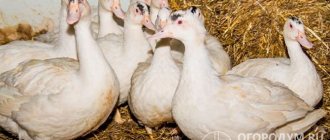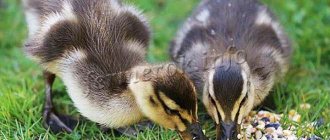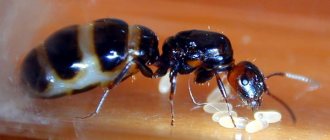2 183
no comments yet
2
Author:
Emelyanenko Gennady.
Reading time: 4 minutes
In modern poultry farming, there are three main areas of breeds and crosses of chickens: egg, meat and meat-egg.
Below is a list of types of chickens that even a novice poultry farmer can breed.
How to properly care for chickens - modern approaches to poultry keeping
Keeping chickens takes a lot of time, effort and money. The use of modern technologies and approaches helps reduce costs. And this, first of all, is the correct organization and equipment of the chicken coop with everything necessary for the existence of birds.
Inside the poultry house - perches, feeders, ventilation through windows
Arranging a chicken coop and nests
The poultry house is built from logs or stone, insulated around the perimeter, not forgetting the ceiling. Inside it is installed:
- perches;
- nests;
- feeders;
- drinking bowls;
- troughs with ash and chalk.
The perches are made of wood and placed in the warmest place. There should be up to 25-30 cm of free space per chicken. The perch steps are arranged in the form of an inclined ladder. It is also worth paying attention to the possibility of growing them in cages. If there are a lot of birds, then cage keeping is the best option.
Important! The distance from the floor to the first step of the perch should not be more than 50-70 cm. There is no need to place them on top of each other. Birds that have climbed to the very top will stain those below with droppings.
Birds on roosts in the evening
There are 0.5 nests for each egg-laying hen. 2-3 birds can easily fly into one nest. For meat breeds, 1 nest for 5-6 individuals is enough. They are placed in the far corner of the house on the floor or on a small hill. Hay and straw are used as filler. Any box with low edges is suitable for the nest itself.
Temperature and lighting in the poultry house
On private farmsteads, birds are kept in a stable with an air temperature of at least +17... +20 degrees in winter. On large farms, the temperature in poultry houses is reduced to +12… +13 degrees. This allows you to save on heating, but does not affect the condition of the birds, which warm each other with their own bodies.
On a note! To regularly measure the temperature in the chicken coop, hang a thermometer.
Heat the room using infrared heaters or lamps. They are also used to extend daylight hours in winter, bringing it to 12-14 hours. There should always be light in the poultry house during the day. Lack of light negatively affects weight gain and laying, and there are fewer eggs.
Temperature and ventilation
Ventilation holes help cool and ventilate the room. They are made in different corners of the room or under the roof. Large fans are installed on farms. To ventilate a small barn, it is enough to open several windows for 10-15 minutes a day.
Feeders, drinkers and ash baths
Circular feeders and nipple drinkers are installed in poultry houses. You need containers to fill them with ash, as birds love to take ash baths. Feeders and drinking bowls are constantly cleaned. After the mash, they are washed immediately, making sure that nothing remains. Spoiled food can cause poisoning.
Circular feeders for the convenience of birds
Cell
The cage is the most important moment in the entire future life of your new ward, so its choice should be approached as responsibly as possible, which we will definitely do in the next material.
To begin with, you should know only the most important features of the choice. The cage should be reliable, safe and comfortable both for the bird itself and for you.
The best option is a stainless steel cage. It is very reliable and durable, easy to clean. And your pet will not be able to pick paint off the rods, diluting its diet with it.
As for size, everything is simple: a big bird needs a big cage. It is also worth remembering that there should be enough space inside for all the required elements: a feeder, a drinker, a perch, a nest box, a bathtub and several toys.
When choosing, it is better to neglect the beauty of the cell, giving preference to a simple rectangular high or wide “box”. The fewer decorative elements it has, the easier it will be to clean it.
An additional plus is the retractable pestle tray. It is very convenient to remove it, practically without disturbing the occupant, and is easy to clean.
And the last important point that is worth remembering at this stage: birds of different types and sizes cannot be housed in the same cage.
How to properly care for chickens
To receive newborn chicks, a place is prepared in advance. If an incubator helps the chicks to be born, then immediately after drying they are placed in a spacious box covered with a soft cloth. It is placed on a mesh wooden bed or boards raised 60-80 cm above the floor. An electric stove or fireplace is placed under the box, and a lamp is mounted on top.
Important! Having a good hen makes the job much easier. The chicken can maintain the desired body temperature of the chicken, it warms it better than a heater, and shows how and what to eat.
The temperature in the room where the chickens are located should not fall below +28... +29 degrees. It is reduced gradually, starting from the 7th day of the brood’s life. It's best to place the chicks in a brooder, but if you don't have one, a box or crate will do just fine. A closed drinking bowl and feeder are placed inside.
Day-old and week-old chicks must always be in the light. Once they reach 2 weeks, daylight hours are reduced to 8-9 hours.
Proper chicken management
Brood feeding schedule
The chicken menu for the day is made up, taking into account its age:
- 0-7 days. The first feeding is carried out 12 hours after birth. The chickens are fed boiled eggs. A day later, they give corn grits, millet and milk. By the end of the week, you can feed them finely chopped greens. There must be water or milk in the drinking bowl. These chickens are fed up to 10 times a day.
- 7-14 days. The chickens are fed green onions and sorrel, potatoes and carrots are ground for them, and cottage cheese is given to them.
- 3 weeks. The menu includes foods that adult chickens eat. The chickens are released for a walk. The number of feedings is reduced to 5-6.
Not all chicks understand how to eat food; some refuse it and die. To prevent this from happening, the goiter is probed after each feeding.
Grown up chicken in a cage
Care of laying hens, feeding
Laying hens are birds that are raised for the purpose of producing eggs. To ensure that the chicken lays eggs often, she is fed:
- ready-made feed;
- greenery;
- pumpkin;
- cucumbers;
- potato;
- carrots;
- whole grains (oats, corn, barley, wheat).
Chalk, shells or bone meal are placed in the feeders. It is beneficial for laying hens to walk in the fresh air and take vitamin supplements. Receiving the necessary amount of vitamins, the chicken lays eggs even during molting.
Important! Keeping laying hens is almost no different from raising regular pullets; the only difference is in the quantity and quality of feed, as well as the need to feed the birds special additives that increase egg production.
Raising poultry on an industrial scale
Ash baths - care and prevention of parasites
A mandatory element of successful keeping and proper care of domestic chickens is the prevention of parasites. A variety of skin parasites - lice, fleas, feather eaters, mites and others - can so exhaust and exhaust a bird that it will not only reduce productivity, but may well die.
Chickens should be able, even indoors, to get rid of parasites and maintain clean feathers, which is important not only from an aesthetic point of view. Clean feathers retain heat well due to air bubbles located between the feather fibers. Wet and dirty feathers will lead to rapid hypothermia or overheating, illness and death of the bird.
An ash box measuring 1.2 × 0.6 m and 25 cm high is installed in one of the corners of the poultry house, pouring into it wood ash mixed with clean river sand in equal proportions. If the mixture becomes dirty, replace it with a fresh one. If the bird is attacked by mites, colloidal sulfur powder can be added to the ash, and after a few days the mixture can be removed by adding the usual composition.
Carrying out a sanitary day in the chicken coop
The chicken coop is regularly cleaned of droppings (at least once a week), and the litter is changed. General cleaning is carried out once every six months. The walls and ceiling are whitened using lime. If fleas and other parasites have settled in the room, then special smoke bombs are used to treat it.
Before processing the premises, all chickens are temporarily relocated to another location. In winter, this is not easy to do due to the lack of additional chicken coops where the poultry flock could be kept. It is better to organize a sanitary day in spring or summer.
Note! If lime is used, it is purchased at the rate of 7-8 kg per 10 square meters. meters. It is also better to whitewash the walls after moving the birds to another barn, but you don’t have to do this, the risk is minimal.
Litter processing
With proper maintenance and proper feeding, chicken droppings are rich in microelements. A large amount of it is a poisonous suspension. Processing chicken manure is an important task that needs the right solution.
The best option is to make compost. To do this, the droppings are mixed with various plant wastes (residues of vegetables and fruits, leaves, weeds), straw, sawdust, peat, shavings. Fresh plants cannot be used for compost.
REFERENCE! Peat is used only if the compost will mature for a year and will have time to decompose.
Keeping chickens at home is not easy, but it is always profitable. As a result, you will not only have food, but also excellent fertilizer for your garden.
Free-range domestic chickens
Domestic chickens should roam freely around the property for at least several hours a day in the summer and at least 10-15 minutes in the winter. They feed on subcutaneous food - they collect worms and beetles, and look for herbs that are beneficial to the body. Birds that roam free fly better, their immune system is strengthened, and the risk of developing dangerous diseases is reduced.
Walking can be organized in a pen adjacent to the chicken coop or in a separate pasture. Birds do not tend to wander far from the dacha, so there is no need to fear that they will disappear if you do not constantly look after them.
Winter bird walking in the yard
Where to put
The two main requirements for the place where the bird cage will be placed are warmth and light. In this case, the window sill will be the least successful option - in cold weather, due to air movement, the bird can catch a cold, and in the summer, being under direct sunlight, it can overheat.
It is best to place the cage on the side or wall opposite the window, at approximately the height of your chest. On cloudy and winter days, artificial lighting will be enough for your pet.
Also, the room where your pet will live must be regularly ventilated, but you need to watch out for drafts so that the bird does not get blown through.
It is better to move in in the morning, so that the new tenant can get used to it during the day and sleep peacefully at night.
Useful tips
When planning to breed birds on an industrial scale or for yourself, you need to consider the following points:
- Chickens consume a lot of feed. If the owners do not plan to receive eggs in winter, then it is better to slaughter the chickens. Birds of meat breeds are disposed of in early autumn.
- You will have to spend money on equipping the chicken coop and nutrients. To keep birds healthy, you need to purchase mineral supplements and vitamins for them. In order for the chickens to lay eggs better, light and heating will need to be installed in the poultry house.
Important! The main thing is to choose the right breed, guided by the description provided by the breeders or personal experience. There are egg, meat and mixed types of pedigree chickens. An adult meat chicken weighs 5-7 kg, roosters weigh more. An egg-laying chicken will lay about 150-200 eggs per year, but its weight at slaughter does not exceed 2.5-3 kg.
Productivity indicators
Productivity indicators mainly depend on the characteristics of the breed or cross and on the conditions of keeping the birds.
Chickens of the egg breed, as a rule, begin to lay eggs at the age of 4.5-5 months; chickens achieve their best productivity indicators in the first 1-2 years of life, then egg production decreases.
The maximum meat productivity of poultry of the corresponding breeds and crosses, as a rule, is reached by 6-12 months, however, there are highly productive crosses that gain maximum weight by 2-3 months.
Chickens of meat and egg breeds begin laying at the age of 5-7 months, peak productivity is observed within 2-3 years, then the indicators decrease. Birds most often gain maximum weight by 6-7 months.
How to properly organize a broiler business?
Read
Chickens for slaughter - when can birds be used for meat?
More details
Broilers are meat chickens that are genetically engineered for rapid weight gain.
Look
The best breeds and crosses of Russian chickens: top 5 most productive chickens
Further










